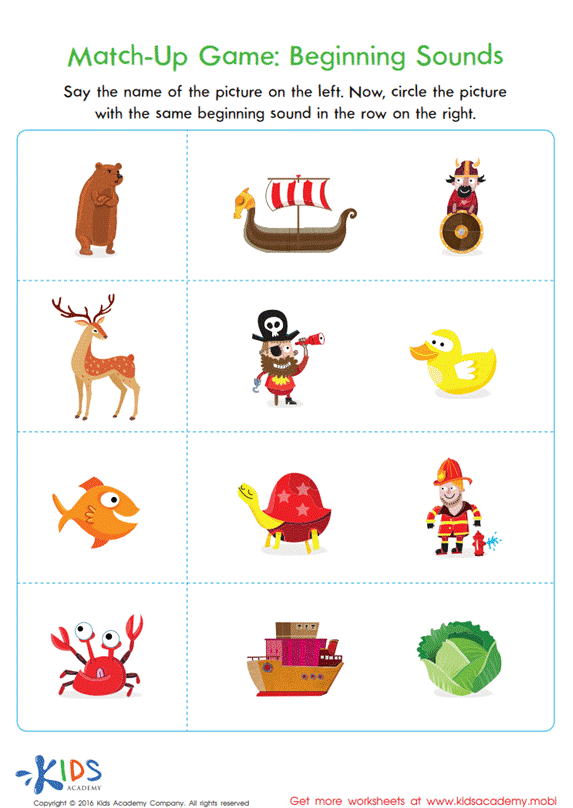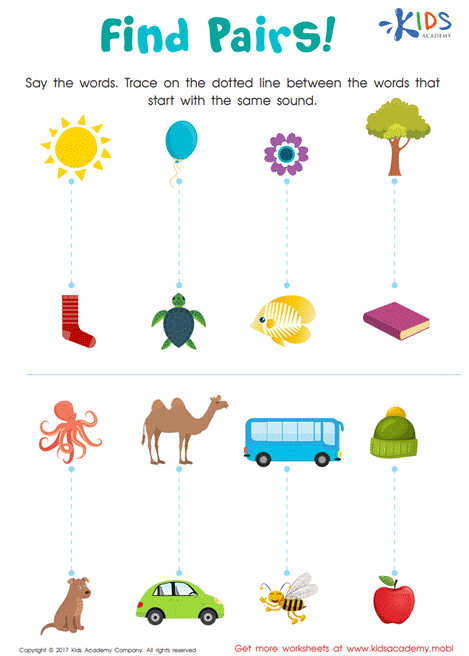-
English
-
English Pre-K
-
Unit 1: Early Literacy Skills
-
ABCs
- Pre-writing Activities
- Letter A
- Letter B
- Letter C
- Letter D
- Letter E
- Letter F
- Letter G
- Letter H
- Letter I
- Letter J
- Letter K
- Letter L
- Letter M
- Letter N
- Letter O
- Letter P
- Letter Q
- Letter R
- Letter S
- Letter T
- Letter U
- Letter V
- Letter W
- Letter X
- Letter Y
- Letter Z
-
Phonological Awareness
- Rhyming Words
- Letter Sounds B, C, D, and F
- Letter Sounds G, H, J, and K
- Letter Sounds L, M, N, and P
- Letter Sounds Q, R, S, and T
- Letter Sounds V, W, X, Y, and Z
- Letter Sounds A, E, and I
- Letter Sounds O and U
- Beginning Sounds
- Matching Letters to Sounds
-
ABCs
-
Unit 2: Vocabulary
-
Common Words
- Sorting Words into Categories
- Color Words
- Verbs and Adjectives
-
Sight Words
- Sight Words 'I' and 'Can'
- Sight Words 'You' and 'Like'
-
Common Words
-
Unit 3: Print Awareness
-
Parts of a Book
- Working with a Book
- Spaces Between Words
- Text and Illustrations
-
Picture Books and Poems
- Picture Book Text Features
- Poem Text Features
- Signs and Labels in the Community
-
Parts of a Book
-
Unit 4: Reading Literature
- Questions About Stories
- Discussing Stories
-
Unit 5: Reading Informational Texts
- Retelling Details in a Text
- Questions About a Text
- Connections Between Events
- Text Features
- Describing Illustrations
-
Unit 1: Early Literacy Skills
-
English Pre-K
-
Math
-
Math for Pre-Kindergarten
-
Logic and Geometry
-
Matching and Sorting
- Same and Different
- Which One Is a Little Different?
- Objects That Go Together
- Sorting by Color and Size
- Sorting The Same Group in Different Ways
- Patterns
-
Shapes
- Shapes in Our Environment
- Naming Shapes Regardless of Size
- Making Shapes in Preschool
- Comparing Shapes
- Relative Positions
- Sorting Shapes
-
Matching and Sorting
-
Early Number Sense
-
Numbers 1–5
- Counting to 3
- Counting to 5
- Arranging Objects up to 3 Objects
- Arranging up to 5 Objects
- Writing Numbers 1–5
-
Numbers 1–5
-
Numbers up to 10
- Counting to 10
- Arranging up to 10 Objects
- Number 0
- Writing Numbers 6–10
- Breaking Down Numbers 6-10
-
Logic and Geometry
-
Math for Pre-Kindergarten
Beginning Sounds
Phonological awareness is a necessary skill your child needs to acquire as they learn how to read and write. Essentially, it is the ability to identify, recognize, segment, blend and generally manipulate sounds. One of the first steps towards achieving this skill is learning how to identify and isolate the first sound of a word. Learning how to isolate initial sounds is a sub-skill to phonological awareness that is best developed through practice. At the pre-k level, learning through fun and play is the most efficient approach. Therefore, in this article, you will find a simple guide on how to teach your child initial sounds using activities and games tailored to their cognitive abilities in order to ensure a smooth learning process.
Activities
One of the easiest exercises you can offer your child to introduce them to initial sounds is simply making conversation. When having breakfast in the morning for example, talk with your child about the foods you’re eating and point out the beginning sounds of their names. For instance, you can explain to them how the word “pancakes” starts with the sound /p/, the same sound as the tool used to make them starts, the pan. Then you ask your child if they can find something else in the kitchen that starts with a /p/ sound.
You can also prepare craft activities to help your little learner practice their initial sound recognition. A fun activity you can set up is hanging two long threads and labeling each with one sound, let’s take /b/ and /p/. Print out 10 images, 5 for each of the two initial sounds: ball, bear, bag, bottle, bed, pot, pen, pool, pear, pig. Help your child name each image and identify which sound it starts with. Then using clothespins, hang it on the corresponding thread. This activity encourages the child to isolate and identify initial sound, in addition to training their fine motor skills through pinching the clothespins.
Worksheets are another great way for children to learn beginning sounds. You can find several different worksheets on our website that motivate your child to practice identifying initial sounds in words. The worksheet below titled “Match Up Game: Beginning Sounds”, for instance, encourages your kid to remember the names of the provided images on the left and isolate their beginning sound in order to match them with the correct images on the right. Help them by matching the first exercise. Explain that the bear on the left starts with a /b/ sound, while on the right hand side we have a boat and a viking. Which of the two starts with a /b/ sound? Try to stress and repeat the initial sound while saying the word, like this: “b-b-bear, b-b-boat, v-v-viking”
This “Find Pairs!” worksheet also works on training your child's ability to isolate the initial sound in order to identify which of the pairs start with the same sound, and which don’t. All they need to do is trace the line between the pairs that do have matching initial sounds. You can also demonstrate it by solving the first pair, 'sun' and 'socks'. Stress the initial letters and ask what your child thinks, do they start with the same sound? If yes, trace the line between them!
Knowing how to identify and isolate initial sounds is a vital skill for developing phonological awareness. Once children master it, they can move on to recognizing sounds and letters in correspondence—building a solid foundation for reading and spelling skills.



